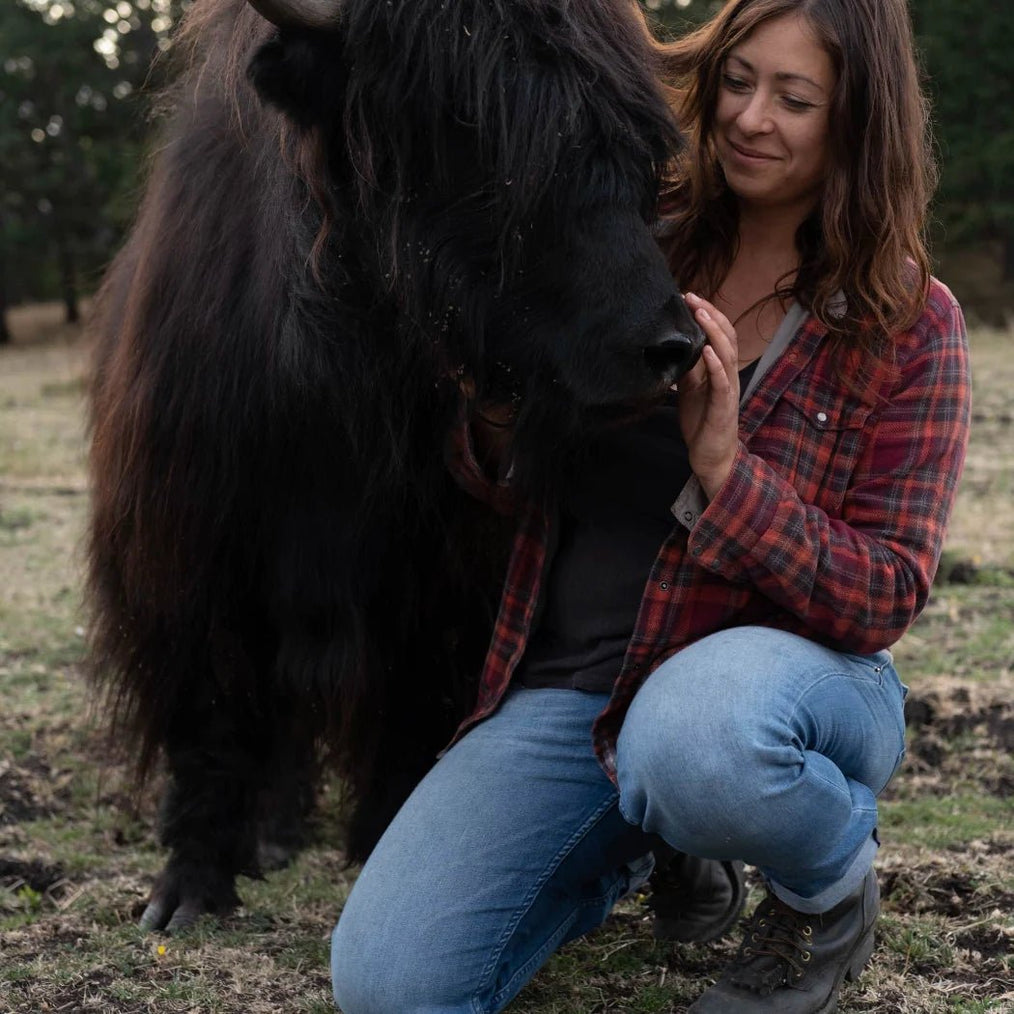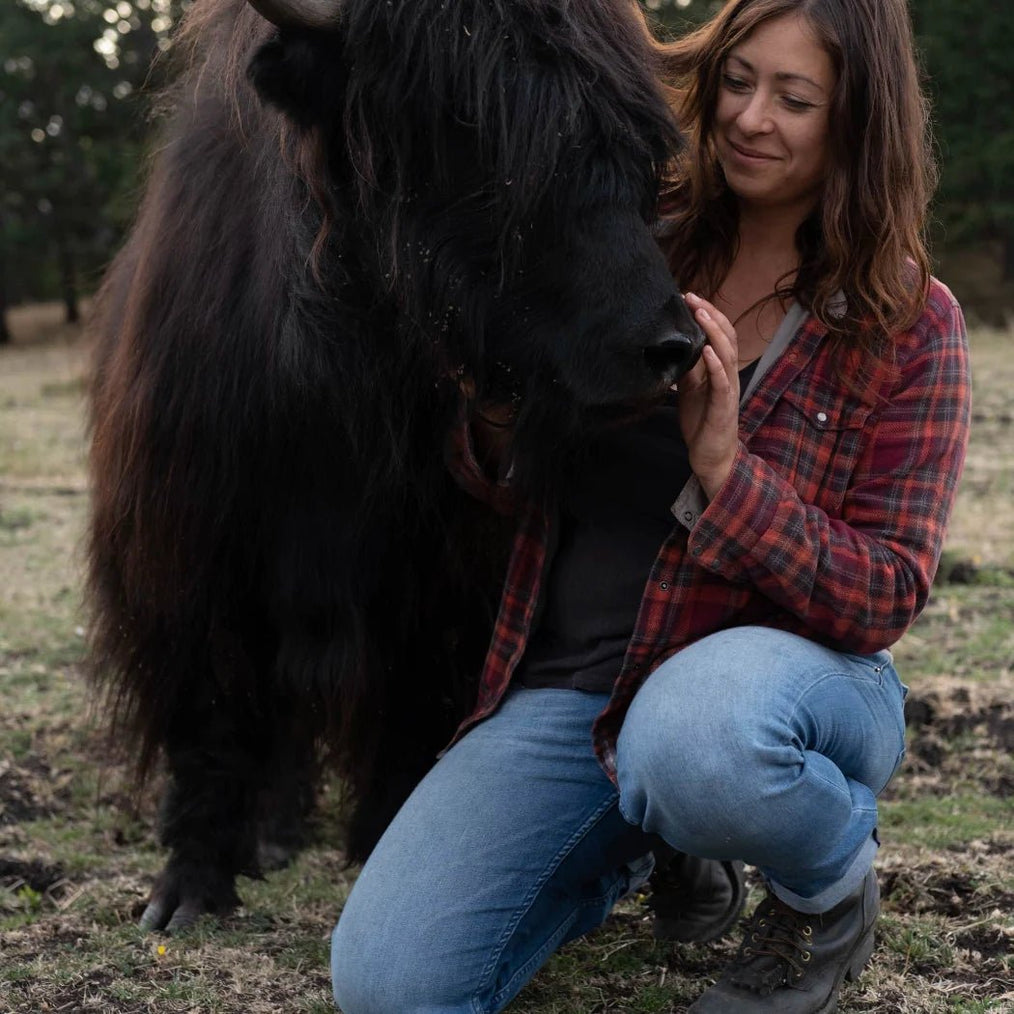If you are searching for the perfect pet companion yaks to add to your family, there are a few things to keep in mind. First, genetics and the right individual animals are the most important thing, regardless of color. Yaks range in temperament and personalities just like people, and there are different styles of “tame” yaks even within the “tame” category. If you want a close connection with your yaks, it is important to visit prospective animals. If you can’t do this, work with a breeder who will provide all relevant information on potential candidates, and can describe their unique temperaments to determine if that animal would be a good fit for you. While the perfect personality yak may not be available in your first color choice, I believe it is important to love what you see when looking at your yaks. If you absolutely must have a royal, for example, you may want to wait until the right yak is available. Often the most gentle, tame and hilarious personalities just appear in the herd and there is no predicting what they will look like. If the stars align and just the color you are looking for is available in the personality you also adore, scoop them up because sometimes things are meant to be! And similarly, if you don’t connect with the yaks you meet in the way you expected, be patient. Maybe they’re just not born yet, on another ranch, or you just need to visit again and spend more time with them to be sure. Our advice is: be patient and get the right yaks the first time. This saves time, money and stress in the long run. If you plan to add yaks to your existing human family involving children, please read our tips on CHILDREN AND YAKS. (link).
Bottle Babies or Weanlings?
At our farm we occasionally have bottle babies due to unforeseen circumstances. In this case, these tame babies often develop differently than yaks raised by their mothers and can make a human-oriented versus yak-oriented pet. However, for their optimal enjoyment of life, we recommend having at least two yaks. You can still have yaks that are bonded to you, who were raised on their mothers. The difference is that they don’t have the instinct as a calf that you are their food source. This can ultimately lead to a safer and more well rounded animal. While I adore the bottle babies I have raised, it is essential to establish boundaries and continue to do so into adulthood. They often do not respect space and can be dangerous if they are left intact as a bull. We do NOT recommend ever having a bull that has been raised by humans. Even cows and steers who were bottle raised can be unaware of spatial boundaries and accidentally hurt humans with their horns. They can also be territorial and jealous with their humans, pushing other yaks away from getting attention and creating unsafe dynamics if you are standing between the animals.
Time: Time spent is tameness earned
It is important to really think about what you want and expect out of your new yaks. Here are some questions to ask yourself about what you want out of your relationship with your future yak friends.
- Do you want to be able to pet and brush them in the pasture?
- Do you want them to let you trim their hooves while laying down?
- Do you have a chute to groom them in or do you expect to handle, doctor and care for your yaks without any additional equipment?
- Do you want to lead them on a halter?
- Do you want to take trips with them?
If you answered yes to ANY of these questions, now it’s important to think about how much time you can allot to working with your yaks. With good, gentle stock, it is easy to get them to eat treats out of your hand or follow you around in the pasture. But if you want them to perform certain tasks, it requires a time investment, patience and consistency. Often people who want tame yaks to pack or ride get part of the way there, but life gets busy and the yaks never reach the objective full level of tameness or performance. So, ask yourself if you would still love having your yaks if you don’t get all the way there, and what adjustments you may need to make in your management if that is the case.
Fiber production
If you are interested in getting yaks for fiber production, there are some things to know. First, when breeders talk about “high fiber” yaks, there are a lot of details within that category. The right yaks for you will depend on your needs and objectives. You can read more about yak fiber HERE (link). Quality of the fiber and amount of production are determined by both genetics and environment. You can have an incredible fiber yak, but if the winters are warm, they may not produce as much as in colder climates. And conversely, even in cold climates, the quality of the down is determined by genetics. For hand spinning and homestead fiber use, the quality of the down and separation from the guard hair is very important. That is a very specific yak, with excellent, low micron fiber, that has clearly discernible larger hairs that can easily be removed by hand for necessary dehairing of the down. For larger herds, each individual may not be as critical, but overall fiber production and quality is the goal, with traits that will be passed down to offspring. Choosing the right bull is important in this situation, in order to maintain quality for future generations. Our herd has all types of fiber. We have our rug-making yaks with thick, coarse hair (and a lot of it!), some that produce large quantities of medium grade fiber, and some that produce high-end down for luxury wearables. Some produce very little fiber at all.
Super wooly: Super wonderful or too much work?
That answer is up to you! I adore the look of super woolies. The individuals in our herd happen to have personalities ranging from adorable to extreme Diva, and they are funny and enjoyable as they are beautiful. However, we must be honest about the amount of grooming required to keep these yaks in good condition and the environment in which they are raised. Grooming at least twice a year is necessary and involves significantly more brushing than other, shorter haired yaks. Some plain coated yaks require no grooming, and these are more suitable for meat operations and those without the time necessary to maintain longer haired yaks. It is also necessary to have equipment to groom them, such as a chute and hand tools. Keep in mind that the amount of guard hair on the exterior coat may not have a correlation to the amount of down fiber production. That depends on genetics and traits of the specific animals. It is possible to have super woolies with good down production, but some produce less because their exterior coat has so much insulation in itself.



